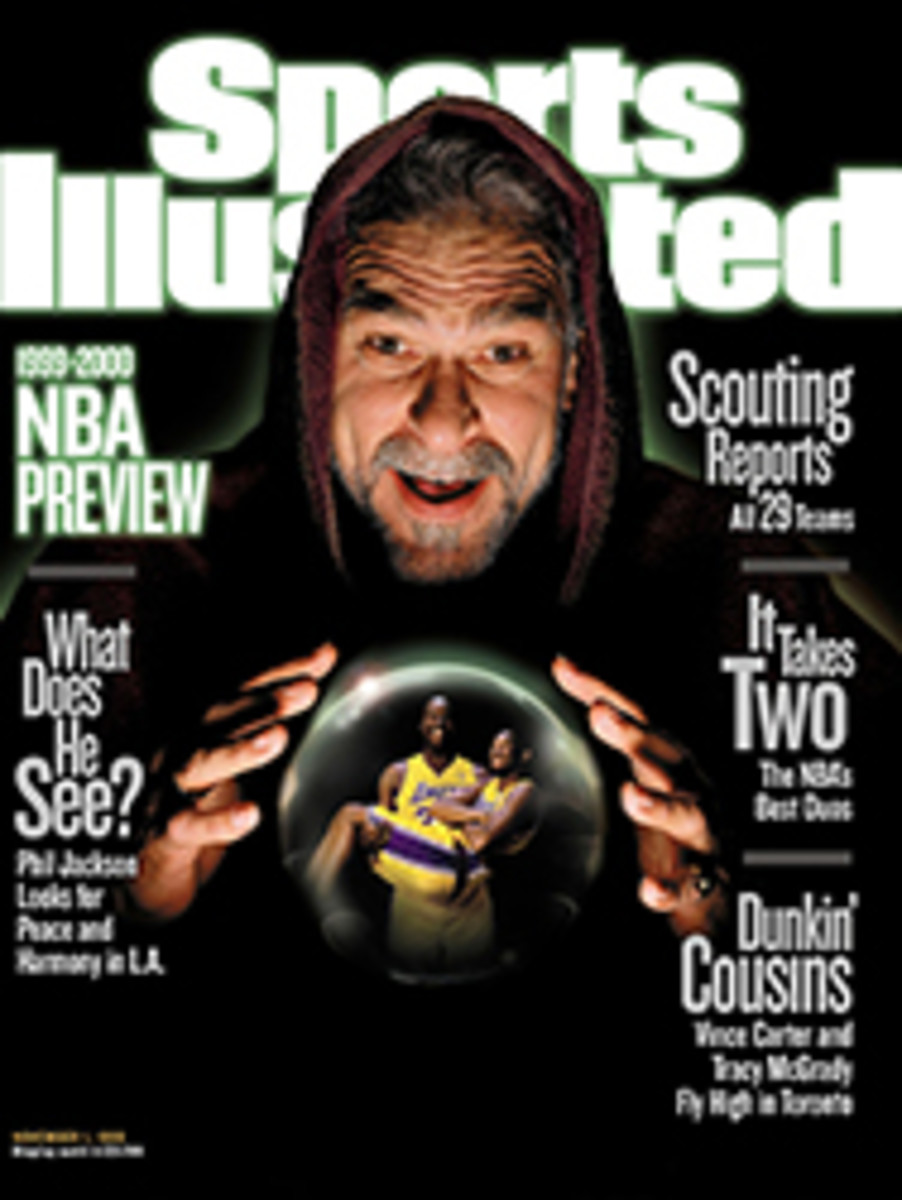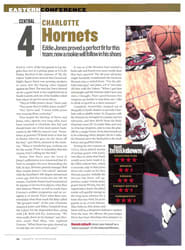
6 Milwaukee Bucks Now that Sam Cassell is healthy, the question is: Will he dish or shoot?
Bucks general manager Ernie Grunfeld was chatting courtside with
a few visitors one morning during training camp when he heard a
small but assertive voice 15 feet away. "Move," it said in no
uncertain terms. "Move, man. I want to shoot a jumper." Grunfeld
did as he was told, and with that, seven-year-old Sam Cassell
Jr., swimming in one of his dad's practice uniforms, took aim at
the ball bin in front of which Grunfeld had been standing. His
shot landed squarely in the target, and there was much rejoicing
and fist pumping from the tiny gunner.
When little Sam's father came to Milwaukee last March in a
three-way trade that sent point guard Terrell Brandon to the
Timberwolves, he brought that same brashness, not to mention the
love of a good jumper, with him. Bucks fans welcomed Sam Sr.'s
outgoing personality. His penchant for shooting while playing the
point, however, wasn't so endearing.
After Cassell's fifth game with the team, a 110-88 drubbing by
the Pacers in the opener of their first-round playoff series, he
was roasted by the press for his quick trigger finger. The guy
entrusted with getting the ball to scorers Ray Allen and Glenn
Robinson had launched 16 shots--the same number as Allen and
Robinson--while totaling just three assists. Columnists pined for
the return of Brandon, who, like Cassell, had been a high-scoring
point before coming to Milwaukee in 1997. By the time Brandon
left, his shot attempts were down and his assists were up. Last
year, the team went 12-5 with him and 16-17 without him.
So will coach George Karl rein in Cassell? "That's dictated by
the game," says Karl. "In [Seattle with] Gary Payton I had a guy
who shot the ball more than anybody on my basketball team. But he
gave us quality play, and that's the same thing I'm going to ask
of Sam. I know he likes to score. I know he can score. He's also
got to be responsible for our shooters getting shots. Sam's a lot
like Gary. He's kind of loud, and he can be obnoxious, even
angry. But the thing I love about Sam is that, like Gary, he
understands the game."
Cassell has demonstrated the ability to be both a scorer and a
passer. In 1997-98 he averaged 19.6 points and 8.0 assists for
the Nets. Ankle injuries limited him to eight regular-season
games last year, and now that he's healthy he's not about to
scale back his shooting just because the Bucks have two
proficient perimeter scorers. "They didn't bring me here to be
Muggsy Bogues," Cassell says. "Some nights I'll score big; some
nights I won't. But getting assists won't be a problem on this
team."
Not with Allen and Robinson around. Both saw their scoring
averages dip a bit last season, but Allen had a career-best field
goal percentage (45.0), and the Big Dog shot a respectable 45.9%
from the floor. Robinson also showed a newfound interest in
defense and was Milwaukee's second-best rebounder, behind Ervin
Johnson, with 5.9 per game. But Johnson's average of 6.4 boards
was among the lowest in the league for a team leader. To enhance
the Bucks' rebounding, Karl, who loves to play small ball, will
place more of an emphasis on size. "I could play 6'10" at two,
and three other 6'10" guys up front," he says. "Just playing
bigger is going to answer some of the rebounding questions."
The 6'10" shooting guard he's referring to is Tim Thomas, who
came from the Sixers in a midseason trade for Tyrone Hill. Karl
has never met a jack-of-all-trades he didn't like, and he quickly
became a fan of Thomas. After seeing time at every position in
summer-league play, Thomas will line up at shooting guard as well
as both forward positions. "His improvement as a player, I think,
will coincide with our improvement as a team," says Karl.
In the off-season the Bucks signed 6'10" free agent J.R. Reid,
who will allow 6'8", 284-pound Robert (Tractor) Traylor to move
from center to power forward. Grunfeld's only other off-season
move was to send bench jockeys Chris Gatling and Armen Gilliam to
the Magic for Dale Ellis and Danny Manning. Ellis will make up
for the loss of three-point marksman Dell Curry, who signed with
Toronto. In addition to being able to play all three frontcourt
positions, Manning is one of the few humans who can boast of
appearing in 10 playoff games for the Clippers. He'll give the
young Bucks someone to look up to. "I think a player can really
be good for your team if he does one thing really well," says
Karl. "Danny Manning understands the game of basketball really
well. He can be a tutor [to Allen and Robinson]."
Grunfeld thinks that the pair is the best shooting guard-small
forward combination in the Eastern Conference, and he might be
right. But, says Karl, "[Allen and Robinson] have got to forget
about numbers and think about doing the dirty work, playing some
defense and showing leadership. They've got to become all-around
basketball players. The next step is going to come in a playoff
series when they lead us to a great win."
The Bucks haven't won a playoff series--great or otherwise--since
1989. But assuming Cassell settles into his role running the
show, come playoff time Allen and Robinson should find that next
step to be well within their reach.
--Mark Bechtel
COLOR PHOTO: GARY DINEEN/NBA PHOTOS GREEN LIGHT Cassell says Karl will give him all the freedom he gave Payton in Seattle.
FAST BREAKDOWN
STARTING FIVE [3 stars]
BENCH [3 stars]
COACH [4 1/2 stars]
FRONT OFFICE [3 1/2 stars]
CHEMISTRY [3 stars]
By the Numbers
1998-99 record: 28-22 (tied for sixth in Eastern Conference)
Coach: George Karl (second season with Bucks)
1998-99 PER GAME POINTS FG% REBOUNDS TURNOVERS
AVERAGES (rank) (rank) (rank) (rank)
BUCKS 91.7 (14) 45.9 (4) 38.8 (28) 14.4 (5)
OPPONENTS 90.0 (11) 42.7 (9) 41.1 (T-13) 16.6 (5)
In Fact
The Bucks made a habit of playing close games last season. A
league-high 35 of Milwaukee's 50 games were decided by single
digits; in 10 of those games the margin of victory was two points
or fewer.
Projected Lineup
STARTERS PVR* 1998-99 KEY STATS
SF Glenn Robinson 33 18.4 ppg 5.9 rpg 2.1 apg 45.9 FG%
Until '98-99 had averaged 20 or more points each year in college
and pros
PF Robert Traylor 158 5.3 ppg 3.7 rpg 0.8 apg 53.7 FG%
Logged just 16.0 minutes per game despite starting 43 times
C J.R. Reid [#] 98 9.0 ppg 5.2 rpg 1.2 apg 47.7 FG%
Averaged 15.2 points in Charlotte before being dealt to Lakers in
March
SG Ray Allen 27 17.1 ppg 4.2 rpg 3.6 apg 45.0 FG%
Tied postseason mark by hitting five three-pointers in one quarter
PG Sam Cassell 36 15.9 ppg 1.9 rpg 4.5 apg 41.9 FG%
Missed 42 games after spraining ankle in 36-point season opener
BENCH PVR* 1998-99 KEY STATS
F Tim Thomas 114 7.2 ppg 2.5 rpg 0.9 apg 47.3 FG%
Was named to All-Rookie second team with Sixers in 1997-98
F Danny Manning [#] 127 9.1 ppg 4.4 rpg 2.3 apg 48.4 FG%
Didn't miss a game because of injury for first time since 1991-92
G Haywoode Workman 180 6.9 ppg 3.5 rpg 5.9 apg 42.9 FG%
Led team in assists after being sidelined two years with knee
injury
G Dale Ellis [#] 199 10.3 ppg 2.4 rpg 0.8 apg 44.1 3FG%
With 1,682, trails Reggie Miller by 20 on alltime list of threes
made
C Ervin Johnson 232 5.1 ppg 6.4 rpg 0.4 apg 1.14 bpg
Has been team leader in total blocks in each of last four seasons
[#] New acquisition
(R) Rookie (statistics for final college year)
*PVR: Player Value Ranking (explanation on page 102)

